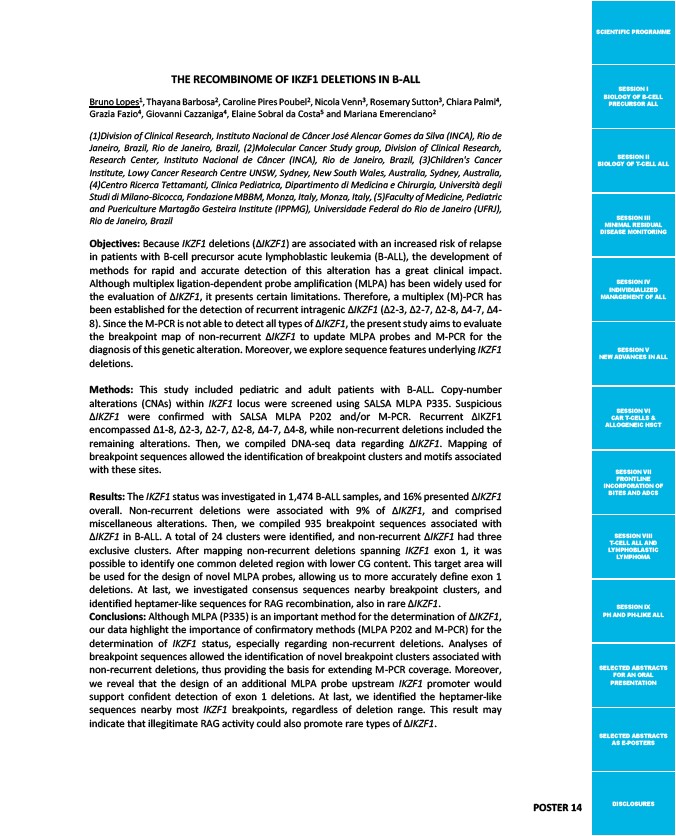
SCIENTIFIC PROGRAMME
SESSION I
BIOLOGY OF B-CELL
PRECURSOR ALL
SESSION II
BIOLOGY OF T-CELL ALL
SESSION III
MINIMAL RESIDUAL
DISEASE MONITORING
SESSION IV
INDIVIDUALIZED
MANAGEMENT OF ALL
SESSION V
NEW ADVANCES IN ALL
SESSION VI
CAR T-CELLS &
ALLOGENEIC HSCT
SESSION VII
FRONTLINE
INCORPORATION OF
BITES AND ADCS
SESSION VIII
T-CELL ALL AND
LYMPHOBLASTIC
LYMPHOMA
SESSION IX
PH AND PH-LIKE ALL
SELECTED ABSTRACTS
FOR AN ORAL
PRESENTATION
SELECTED ABSTRACTS
AS E-POSTERS
DISCLOSURES
THE RECOMBINOME OF IKZF1 DELETIONS IN B-ALL
Bruno Lopes1, Thayana Barbosa2, Caroline Pires Poubel2, Nicola Venn3, Rosemary Sutton3, Chiara Palmi4,
Grazia Fazio4, Giovanni Cazzaniga4, Elaine Sobral da Costa5 and Mariana Emerenciano2
(1)Division of Clinical Research, Instituto Nacional de Câncer José Alencar Gomes da Silva (INCA), Rio de
Janeiro, Brazil, Rio de Janeiro, Brazil, (2)Molecular Cancer Study group, Division of Clinical Research,
Research Center, Instituto Nacional de Câncer (INCA), Rio de Janeiro, Brazil, (3)Children's Cancer
Institute, Lowy Cancer Research Centre UNSW, Sydney, New South Wales, Australia, Sydney, Australia,
(4)Centro Ricerca Tettamanti, Clinica Pediatrica, Dipartimento di Medicina e Chirurgia, Università degli
Studi di Milano-Bicocca, Fondazione MBBM, Monza, Italy, Monza, Italy, (5)Faculty of Medicine, Pediatric
and Puericulture Martagão Gesteira Institute (IPPMG), Universidade Federal do Rio de Janeiro (UFRJ),
Rio de Janeiro, Brazil
Objectives: Because IKZF1 deletions (ΔIKZF1) are associated with an increased risk of relapse
in patients with B-cell precursor acute lymphoblastic leukemia (B-ALL), the development of
methods for rapid and accurate detection of this alteration has a great clinical impact.
Although multiplex ligation-dependent probe amplification (MLPA) has been widely used for
the evaluation of ΔIKZF1, it presents certain limitations. Therefore, a multiplex (M)-PCR has
been established for the detection of recurrent intragenic ΔIKZF1 (Δ2-3, Δ2-7, Δ2-8, Δ4-7, Δ4-
8). Since the M-PCR is not able to detect all types of ΔIKZF1, the present study aims to evaluate
the breakpoint map of non-recurrent ΔIKZF1 to update MLPA probes and M-PCR for the
diagnosis of this genetic alteration. Moreover, we explore sequence features underlying IKZF1
deletions.
Methods: This study included pediatric and adult patients with B-ALL. Copy-number
alterations (CNAs) within IKZF1 locus were screened using SALSA MLPA P335. Suspicious
ΔIKZF1 were confirmed with SALSA MLPA P202 and/or M-PCR. Recurrent ΔIKZF1
encompassed Δ1-8, Δ2-3, Δ2-7, Δ2-8, Δ4-7, Δ4-8, while non-recurrent deletions included the
remaining alterations. Then, we compiled DNA-seq data regarding ΔIKZF1. Mapping of
breakpoint sequences allowed the identification of breakpoint clusters and motifs associated
with these sites.
Results: The IKZF1 status was investigated in 1,474 B-ALL samples, and 16% presented ΔIKZF1
overall. Non-recurrent deletions were associated with 9% of ΔIKZF1, and comprised
miscellaneous alterations. Then, we compiled 935 breakpoint sequences associated with
ΔIKZF1 in B-ALL. A total of 24 clusters were identified, and non-recurrent ΔIKZF1 had three
exclusive clusters. After mapping non-recurrent deletions spanning IKZF1 exon 1, it was
possible to identify one common deleted region with lower CG content. This target area will
be used for the design of novel MLPA probes, allowing us to more accurately define exon 1
deletions. At last, we investigated consensus sequences nearby breakpoint clusters, and
identified heptamer-like sequences for RAG recombination, also in rare ΔIKZF1.
Conclusions: Although MLPA (P335) is an important method for the determination of ΔIKZF1,
our data highlight the importance of confirmatory methods (MLPA P202 and M-PCR) for the
determination of IKZF1 status, especially regarding non-recurrent deletions. Analyses of
breakpoint sequences allowed the identification of novel breakpoint clusters associated with
non-recurrent deletions, thus providing the basis for extending M-PCR coverage. Moreover,
we reveal that the design of an additional MLPA probe upstream IKZF1 promoter would
support confident detection of exon 1 deletions. At last, we identified the heptamer-like
sequences nearby most IKZF1 breakpoints, regardless of deletion range. This result may
indicate that illegitimate RAG activity could also promote rare types of ΔIKZF1.
POSTER 14